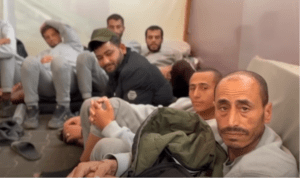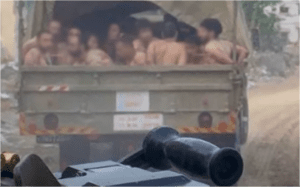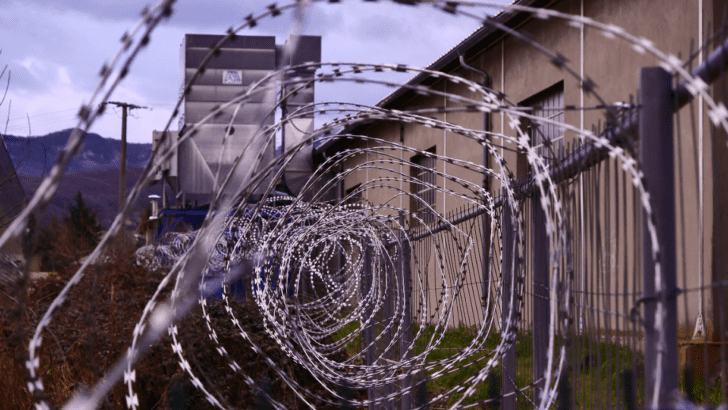Since Israel invaded Gaza, the Sde Teiman military base has filled with blindfolded, handcuffed detainees, held without charge or legal representation.
By Patrick Kingsley and Bilal Shbair, reposted from The New York Times, June 6, 2024
Patrick Kingsley, from Israel, and Bilal Shbair, from Gaza, spent three months interviewing Israeli soldiers who worked at Sde Teiman and Palestinians held there. Patrick Kingsley visited the site.
The New York Times visited part of the Sde Teiman base, which has become synonymous with the detention of Gazans, in May.
The men sat in rows, handcuffed and blindfolded, unable to see the Israeli soldiers who stood watch over them from the other side of a mesh fence.
They were barred from talking more loudly than a murmur, and forbidden to stand or sleep except when authorized.
A few knelt in prayer. One was being inspected by a paramedic. Another was briefly allowed to remove his handcuffs to wash himself. The hundreds of other Gazan detainees sat in silence. They were all cut off from the outside world, prevented for weeks from contacting lawyers or relatives.
This was the scene one afternoon in late May at a military hangar inside Sde Teiman, an army base in southern Israel that has become synonymous with the detention of Gazan Palestinians. Most Gazans captured since the start of the war on Oct. 7 have been brought to the site for initial interrogation, according to the Israeli military.
The military, which has not previously granted access to the media, allowed The New York Times to briefly see part of the detention facility as well as to interview its commanders and other officials, on condition of preserving their anonymity.
Once an obscure barracks, Sde Teiman is now a makeshift interrogation site and a major focus of accusations that the Israeli military has mistreated detainees, including people later determined to have no ties to Hamas or other armed groups. In interviews, former detainees described beatings and other abuse in the facility.

By late May, roughly 4,000 Gazan detainees had spent up to three months in limbo at Sde Teiman, including several dozen people captured during the Hamas-led terrorist attacks on Israel in October, according to the site commanders who spoke to The Times.
After interrogation, around 70 percent of detainees had been sent to purpose-built prisons for further investigation and prosecution, the commanders said. The rest, at least 1,200 people, had been found to be civilians and returned to Gaza, without charge, apology or compensation.
“My colleagues didn’t know whether I was dead or alive,” said Muhammad al-Kurdi, 38, an ambulance driver whom the military has confirmed was held at Sde Teiman late last year.
“I was imprisoned for 32 days,” said Mr. al-Kurdi. He said he had been captured in November after his convoy of ambulances attempted to pass through an Israeli military checkpoint south of Gaza City.
“It felt like 32 years,” he added.
A three-month investigation by The New York Times — based on interviews with former detainees and with Israeli military officers, doctors and soldiers who served at the site; the visit to the base; and data about released detainees provided by the military — found those 1,200 Palestinian civilians have been held at Sde Teiman in demeaning conditions without the ability to plead their cases to a judge for up to 75 days. Detainees are also denied access to lawyers for up to 90 days and their location is withheld from rights groups as well as from the International Committee of the Red Cross, in what some legal experts say is a contravention of international law.
Eight former detainees, all of whom the military has confirmed were held at the site and who spoke on the record, variously said they had been punched, kicked and beaten with batons, rifle butts and a hand-held metal detector while in custody. One said his ribs were broken after he was kneed in the chest and a second detainee said his ribs broke after he was kicked and beaten with a rifle, an assault that a third detainee said he had witnessed. Seven said they had been forced to wear only a diaper while being interrogated. Three said they had received electric shocks during their interrogations.

Most of these allegations were echoed in interviews conducted by officials from UNRWA, the main U.N. agency for Palestinians, an institution that Israel says has been infiltrated by Hamas, a charge the agency denies. The agency conducted interviews with hundreds of returning detainees who reported widespread abuse at Sde Teiman and other Israeli detention facilities, including beatings and the use of an electric probe.
An Israeli soldier who served at the site said that fellow soldiers had regularly boasted of beating detainees and saw signs that several people had been subjected to such treatment. Speaking on condition of anonymity to avoid prosecution, he said a detainee had been taken for treatment at the site’s makeshift field hospital with a bone that had been broken during his detention, while another was briefly taken out of sight and returned with bleeding around his rib cage. The soldier said that one person had died at Sde Teiman from trauma injuries to his chest, though it was unclear whether his injury was sustained before or after reaching the base.

Of the 4,000 detainees housed at Sde Teiman since October, 35 have died either at the site or after being brought to nearby civilian hospitals, according to officers at the base who spoke to The Times during the May visit. The officers said some of them had died because of wounds or illnesses contracted before their incarceration and denied any of them had died from abuse. Military prosecutors are investigating the deaths.
During the visit, senior military doctors said they had never observed any signs of torture and commanders said they tried to treat detainees as humanely as possible. They confirmed that at least 12 soldiers had been dismissed from their roles at the site, some of them for excessive use of force.
In recent weeks, the base has attracted growing scrutiny from the media, including a CNN report later cited by the White House, as well as from Israel’s Supreme Court, which on Wednesday began to hear a petition from rights groups to close the site. In response to the petition, the Israeli government said that it was reducing the number of detainees at Sde Teiman and improving conditions there; the Israeli military has already set up a panel to investigate the treatment of detainees at the site.
In a lengthy statement for this article, the Israel Defense Forces denied that “systematic abuse” had taken place at Sde Teiman. Presented with individual allegations of abuse, the military said the claims were “evidently inaccurate or completely unfounded,” and might have been invented under pressure from Hamas. It did not give further details.

“Any abuse of detainees, whether during their detention or during interrogation, violates the law and the directives of the I.D.F. and as such is strictly prohibited,” the military statement said. “The I.D.F. takes any acts of this kind, which are contrary to its values, with utmost seriousness, and thoroughly examines concrete allegations concerning the abuse of detainees.” The Shin Bet, Israel’s domestic intelligence agency, which conducts some of the interrogations at the base, said in a brief statement that all of its interrogations were “conducted in accordance with the law.”
Yoel Donchin, a military doctor serving at the site, said it was unclear why Israeli soldiers had captured many of the people he treated there, some of whom were highly unlikely to have been combatants involved in the war. One was paraplegic, another weighed roughly 300 pounds and a third had breathed since childhood through a tube inserted into his neck, he said.
“Why they brought him — I don’t know,” Dr. Donchin said.
“They take everyone,” he added.
How Detainees Are Captured:
Fadi Bakr, a law student from Gaza City, said he was captured on Jan. 5 by Israeli soldiers near his family home. Displaced by fighting earlier in the war, Mr. Bakr, 25, had returned to his neighborhood to search for flour, only to get caught in the middle of a firefight and wounded, he said.
The Israelis found him bleeding after the fighting stopped, he said. They stripped him naked, confiscated his phone and savings, beat him repeatedly and accused him of being a militant who had survived the battle, he said.
“Confess now or I will shoot you,” Mr. Bakr remembered being told.
“I am a civilian,” Mr. Bakr recalled replying, to no avail.
The circumstances of Mr. Bakr’s arrest mirror those of other former detainees interviewed by The Times.
Several said they had been suspected of militant activity because soldiers had encountered them in areas the military thought were harboring Hamas fighters, including hospitals, U.N. schools or depopulated neighborhoods like Mr. Bakr’s.
Younis al-Hamlawi, 39, a senior nurse, said he was arrested in November after leaving Al-Shifa Hospital in Gaza City during an Israeli raid on the site, which Israel considered a Hamas command center. Israeli soldiers accused him of having ties to Hamas.
Mr. al-Kurdi, the ambulance driver, said he had been captured while he attempted to bring patients through an Israeli checkpoint. Israeli officials say that Hamas fighters routinely use ambulances.
All of the eight former detainees described their capture in similar ways: They were generally blindfolded, handcuffed with zip ties and stripped naked except for their underwear, so that Israeli soldiers could be sure they were unarmed.
Most said they were interrogated, punched and kicked while still in Gaza, and some said they were beaten with rifle butts. Later, they said, they were crammed with other half-naked detainees into military trucks and driven to Sde Teiman.
Some said they had later spent time in the official Israeli prison system, while others said they were brought straight back to Gaza.
During his month at the site, Mr. Bakr spent four days, on and off, under interrogation, he said.
“I consider them the worst four days of my entire life,” said Mr. Bakr.
How the Site Developed:
During previous wars with Hamas, including the 50-day conflict in 2014, the Sde Teiman military base intermittently held small numbers of captured Gazans. A command center and warehouse for military vehicles, the base was selected because it is close to Gaza and houses an outpost of the military police, who oversee military detention facilities.
In October, Israel started using the site to detain people captured in Israel during the Hamas-led attack, housing them in an empty tank hangar, according to the site commanders. Once Israel invaded Gaza at the end of that month, Sde Teiman began receiving so many people that the military refitted three other hangars to detain them and converted a military police office to create more space for interrogations, they said.
By late May, they said, the base included three detention sites: the hangars where detainees are guarded by military police; nearby tents, where detainees are treated by military doctors; and an interrogation facility in a separate part of the base that is staffed by intelligence officers from Israel’s military intelligence directorate and the Shin Bet.
Classified as “unlawful combatants” under Israeli legislation, detainees at Sde Teiman can be held for up to 75 days without judicial permission and 90 days without access to a lawyer, let alone a trial.

The Israeli military says these arrangements are permitted by the Geneva Conventions that govern international conflict, which allow the internment of civilians for security reasons. The commanders at the site said that it was essential to delay access to lawyers in order to prevent Hamas fighters from conveying messages to their leaders in Gaza, hindering Israel’s war effort.
After an initial interrogation at Sde Teiman, detainees still suspected of having militant ties are usually transferred to another military site or a civilian prison. In the civilian system, they are supposed to be formally charged; in May, the government said in a submission to Israel’s Supreme Court that it had started criminal proceedings against “hundreds” of people captured since Oct. 7, without giving further details about the exact number of cases or their status. There have been no known trials of Gazans captured since October.
Experts on international law say Israel’s system around initial detention is more restrictive than many Western counterparts in terms of the time it takes for judges to review each case, as well as in the lack of access for Red Cross staff.
Early in its war against the Taliban in Afghanistan, the United States also delayed independent review of a detainee’s case for 75 days, said Lawrence Hill-Cawthorne, a law professor who wrote an overview of the laws governing detention of nonstate combatants. The U.S. shortened that delay in 2009 to 60 days, while in Iraq cases were reviewed within a week, the professor said.
Israel’s decision to delay judicial review of a case for 75 days without providing access to lawyers or the Red Cross “looks to me like a form of incommunicado detention, which itself is a violation of international law,” Professor Hill-Cawthorne said.
After Mr. Bakr disappeared suddenly in January, he said, his family had no way of finding out where he was. They assumed he was dead.
Where the Detainees Live:
Inside Sde Teiman, Mr. Bakr was held in an open-sided hangar where he said he was forced, with hundreds of others, to sit handcuffed in silence on a mat for up to 18 hours a day. The hangar had no external wall, leaving it open to the rain and the cold, and guards watched him from the other side of a mesh fence.
All the detainees wore blindfolds — except for one, known by the Arabic word “shawish,” which means sergeant. The shawish acted as a go-between the soldiers and the prisoners, doling out food and escorting fellow prisoners to a block of portable toilets in the corner of the hangar.
Weeks later, Mr. Bakr said, he was appointed as a shawish, allowing him to see his surroundings properly.
His account broadly matches that of other detainees and is consistent with what The Times was shown at the site in late May.
The commanders at the site said detainees were allowed to stand up every two hours to stretch, sleep between roughly 10 p.m. and 6 a.m. and pray at any time. For a brief period in October, they said, detainees were allowed to take off their blindfolds and move around freely within the hangars. But that arrangement ended after some detainees became unruly or tried to unlock their handcuffs, the commanders said.
Exhausted after the journey to Sde Teiman, Mr. Bakr fell asleep soon after his arrival — prompting an officer to summon him to a nearby command room, he said.
The officer began beating him, Mr. Bakr said. “This is the punishment for anyone who sleeps,” he recalled the officer saying.
Others described similar responses to minor infractions. Rafiq Yassin, 55, a builder detained in December, said he was beaten repeatedly in his abdomen after trying to peek from underneath his blindfold. He said he began vomiting blood and was treated at a civilian hospital in the nearby city of Beersheba. Asked about the claim, the hospital referred The Times to the health ministry, which declined to comment.
The Israeli soldier who witnessed abuses at a hangar said one detainee was beaten so hard that his ribs bled after he was accused of peeking beneath his blindfold, while another was beaten after talking too loudly too often.
The Times did not witness any beatings during the visit to the hangar, where some detainees were seen praying while others were assessed by paramedics or brought by the shawish to wash in a sink at the back of the hangar. One man could be seen peeking beneath his blindfold without immediate punishment.
Like the other former detainees, Mr. Bakr recalled receiving three meager snacks on most days — typically bread served with small quantities of either cheese, jam or tuna, and occasionally cucumbers and tomatoes. The military said that the food provisions had been “approved by an authorized nutritionist in order to maintain their health.”
According to several former detainees, it was not enough. Three said they lost more than 40 pounds during their detention.
Some medical treatment is available on site. The commanders brought The Times to an office where they said medics screened every detainee on arrival, in addition to monitoring them every day in the hangars. Serious cases are treated in a nearby cluster of tents that form a makeshift field hospital.
Inside those tents, patients are blindfolded and handcuffed to their beds, in accordance with a health ministry document outlining policies for the site, which was reviewed by The Times.
During the visit, four medics at the hospital said those measures were necessary to prevent attacks on the medical staff. They said that at least two prisoners had tried to assault medics during their treatment.
But others, including Dr. Donchin, said that in many cases the handcuffs were unnecessary and made it harder to treat people properly.

Two Israelis who were at the hospital last year said that its staff members were much less experienced and more poorly equipped during earlier phases of the war. One of them, who spoke on condition of anonymity to avoid prosecution, said that at the time patients were not given enough painkillers during painful procedures.
Physicians for Human Rights, a rights group in Israel, said in a report in April that the field hospital was “a low point for medical ethics and professionalism.”
The hospital’s current leadership acknowledged that it had not always been as well-equipped as it has become, but said its staff was always highly experienced.
Dr. Donchin said in some respects the treatment at the field clinic was now “a little better” than in Israeli civilian hospitals, mainly because it was staffed by some of the best doctors in Israel. Dr. Donchin, a lieutenant colonel in the military reserve, was a long-serving anesthesiologist at a major hospital in Jerusalem and now teaches at a leading medical school.
The facilities and equipment seen by The Times included an anesthesia machine, an ultrasound monitor, X-ray equipment, a device for analyzing blood samples, a small operating theater and a storeroom containing hundreds of medicines.
Doctors serving at Sde Teiman who spoke to The Times said they were also told not to write their names on any official documentation and not to address each other by name in front of the patients.
Dr. Donchin said that officials feared they could be identified and charged with war crimes at the International Criminal Court.
During The Times’s visit, three doctors said they did not fear prosecution but sought anonymity to prevent Hamas and their allies from attacking them or their families.
How the Interrogations Work:
Roughly four days after his arrival, Mr. Bakr said he was called in for interrogation.
Like others who spoke to The Times, he remembered being brought to a separate enclosure that the detainees called the “disco room” — because, they said, they were forced to listen to extremely loud music that prevented them from sleeping. Mr. Bakr considered it a form of torture, saying it was so painful that blood began to trickle from inside his ear.
The Israeli military said that the music was “not high and not harmful,” played within earshot of Israelis and Palestinians alike, and was meant to prevent the detainees from easily conferring with each other before interrogation. The Times was not shown any part of the interrogation complex, including the area where music was played.
Wearing nothing but a diaper, Mr. Bakr said, he was then brought to a separate room to be questioned.
The interrogators accused him of Hamas membership and showed him photographs of militants to see if he could identify them. They also asked him about the whereabouts of hostages, as well as a senior Hamas leader who lived near Mr. Bakr’s family home. When Mr. Bakr denied any connection to the group or knowledge of the pictured men, he was beaten repeatedly, he said.
Mr. al-Hamlawi, the senior nurse, said a female officer had ordered two soldiers to lift him up and press his rectum against a metal stick that was fixed to the ground. Mr. al-Hamlawi said the stick penetrated his rectum for roughly five seconds, causing it to bleed and leaving him with “unbearable pain.”
A leaked draft of the UNRWA report detailed an interview that gave a similar account. It cited a 41-year-old detainee who said that interrogators “made me sit on something like a hot metal stick and it felt like fire,” and also said that another detainee “died after they put the electric stick up” his anus.
Mr. al-Hamlawi recalled being forced to sit in a chair wired with electricity. He said he was shocked so often that, after initially urinating uncontrollably, he then stopped urinating for several days. Mr. al-Hamlawi said he, too, had been forced to wear nothing but a diaper, to stop him from soiling the floor.
Ibrahim Shaheen, 38, a truck driver detained in early December for nearly three months, said he was shocked roughly half a dozen times while sitting in a chair. Officers accused him of concealing information about the location of dead hostages, Mr. Shaheen said.
Mr. Bakr also said he was forced to sit in chair wired with electricity, sending a current pulsing through his body that made him pass out.
Released Without Charge:
After more than a month in detention, Mr. Bakr said, the officers seemed to accept his innocence.
Early one morning in February, Mr. Bakr was put on a bus heading to Israel’s border with southern Gaza: After a month of detention, he was about to be released.
He said he asked for his phone and the 7,200 shekels (roughly $2,000) that had been confiscated from him during his arrest in Gaza, before he reached Sde Teiman.
In response, a soldier hit and shouted at him, Mr. Bakr said. “No one should ask about his phone or his money,” the soldier said, according to Mr. Bakr.
The military said all personal belongings were documented and placed in sealed bags after detainees arrived at Sde Teiman, and returned on their release.
Around dawn, the bus arrived at the Kerem Shalom crossing point, near the southern tip of Gaza.
Like other returned detainees, Mr. Bakr walked for roughly a mile before being greeted by aid workers from the Red Cross. They fed him and briefly checked his medical condition. Then they brought him to a nearby terminal where, he said, he was briefly interrogated by Hamas security officials about his time in Israel.
Borrowing a phone, he called his family, who were still 20 miles away in Gaza City.
It was the first time that they had heard from him in more than a month, Mr. Bakr said.
“They asked me, ‘Are you alive?’”
Iyad Abuheweila contributed reporting from Istanbul; Gabby Sobelman from Rehovot, Israel; and Ronen Bergman from Tel Aviv.Patrick Kingsley is The Times’s Jerusalem bureau chief, leading coverage of Israel, Gaza and the West Bank. He has been an international reporter for more than a decade, reporting from more than 50 countries and territories. Mostly in the Middle East, living in Cairo, Amman and Jerusalem, Berlin and Istanbul. As a reporter for The Times, he is committed to upholding the values and standards outlined in our Ethical Journalism Handbook.
RELATED ARTICLES:
- A statistic 1,000 times too small doesn’t warrant a correction in the NY Times
- Leaked New York Times Memo Tells Journalists To Avoid Words “Genocide,” “Ethnic Cleansing,” and “Occupied Territory”
- How Israeli prison doctors assist in the torture of Palestinian detainees
- Hostages of Israeli revenge in the Gaza Strip: Testimonies of 100 released Palestinian detainees reveal crimes of torture, cruel treatment
- The writing was on the wall for Israel’s torture of prisoners
- Palestinian Released From Israeli Prison Describes Beatings, Sexual Abuse and Torture
- Israel’s torture and humiliation of female and male Gazan prisoners
- 95% of Congress is ok with Israel’s torture of Palestinian children
- How Israeli doctors enable the Shin Bet’s torture industry
- New Israel Supreme Court ruling gives further backing to use of torture
- Torture, Israeli-style – as described by the interrogators themselves





